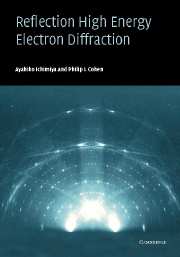Book contents
- Frontmatter
- Contents
- Preface
- 1 Introduction
- 2 Historical survey
- 3 Instrumentation
- 4 Wave properties of electrons
- 5 The diffraction conditions
- 6 Geometrical features of the pattern
- 7 Kikuchi and resonance patterns
- 8 Real diffraction patterns
- 9 Electron scattering by atoms
- 10 Kinematic electron diffraction
- 11 Fourier components of the crystal potential
- 12 Dynamical theory – transfer matrix method
- 13 Dynamical theory – embedded R-matrix method
- 14 Dynamical theory – integral method
- 15 Structural analysis of crystal surfaces
- 16 Inelastic scattering in a crystal
- 17 Weakly disordered surfaces
- 18 Strongly disordered surfaces
- 19 RHEED intensity oscillations
- Appendix A: Fourier representations
- Appendix B: Green's functions
- Appendix C: Kirchhoff's diffraction theory
- Appendix D: A simple eigenvalue problem
- Appendix E: Waller and Hartree equation
- Appendix F: Optimization of dynamical calculation
- Appendix G: Scattering factor
- References
- Index
12 - Dynamical theory – transfer matrix method
Published online by Cambridge University Press: 06 July 2010
- Frontmatter
- Contents
- Preface
- 1 Introduction
- 2 Historical survey
- 3 Instrumentation
- 4 Wave properties of electrons
- 5 The diffraction conditions
- 6 Geometrical features of the pattern
- 7 Kikuchi and resonance patterns
- 8 Real diffraction patterns
- 9 Electron scattering by atoms
- 10 Kinematic electron diffraction
- 11 Fourier components of the crystal potential
- 12 Dynamical theory – transfer matrix method
- 13 Dynamical theory – embedded R-matrix method
- 14 Dynamical theory – integral method
- 15 Structural analysis of crystal surfaces
- 16 Inelastic scattering in a crystal
- 17 Weakly disordered surfaces
- 18 Strongly disordered surfaces
- 19 RHEED intensity oscillations
- Appendix A: Fourier representations
- Appendix B: Green's functions
- Appendix C: Kirchhoff's diffraction theory
- Appendix D: A simple eigenvalue problem
- Appendix E: Waller and Hartree equation
- Appendix F: Optimization of dynamical calculation
- Appendix G: Scattering factor
- References
- Index
Summary
Plan of Chapters 12–14
There are now a number of different dynamical calculations of the intensity of high-energy electrons reflected from surfaces. They face similar difficulties and give results of similar accuracy, but there is no obviously best method. In Chapters 12–14 we present methods due to Ichimiya (1983, 1985), Zhao et al. (1988) and Maksym and Beeby (1981) in sufficient detail that the reader should be able to perform these calculations for real surfaces. The discussions of each are nearly self-contained and simple examples are provided to illustrate the methods. Our intent is to present these dynamical theories so that their important contributions to RHEED can be seen, as well as to allow surface structures to be determined. These are simple theories with some complicated algebra. We will try to present the work in such a way as to convey the overall method first, leaving detailed computations to later subsections. In order to calculate RHEED intensities, optimization is needed. The details of the optimization are described in Appendix F.
Introduction
The dynamical theory is based on a Bloch-wave solution of the Schrödinger equation for a system with a fast electron and a crystal potential that is periodic in two dimensions. Only elastic scattering is considered, with the electron momentum conserved up to a reciprocal lattice vector of the two-dimiensional crystal.
- Type
- Chapter
- Information
- Reflection High-Energy Electron Diffraction , pp. 161 - 172Publisher: Cambridge University PressPrint publication year: 2004

